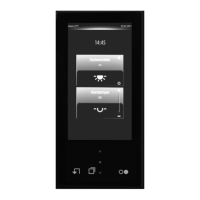Art. No. SC 1000 KNX
1 Product definition
1.1 Product catalogue
Product name: Smart Control
Use: Sensor / Display
Design: FM (flush-mounted)
Art. No. SC 1000 KNX
1.2 Function
The Smart Control is a control and display unit for controlling and visualising building functions.
The device has a TFT graphic colour screen (10.9 cm, 800 x 480 pixels, 16.7 million colours)
with a touchscreen sensor surface. The display elements are operated by simply touching the
glass surface directly.
The Smart Control can be integrated into the KNX building systems with the aid of the KNX
communication module. This device then combines the functions of a KNX/EIB bus coupling
unit, push button sensor, room temperature controller, timer and display unit in just one bus
subscriber. The combination of these functions makes it possible, for example, to control the
light, the blinds, and the room temperature centrally from the entry area of a room.
This product documentation describes the device functionality in combination with the KNX
communication module.
In order to make optimum use of the wide range of operating and display functions, the device
has a user interface that is clearly and logically structured according to functions, rooms and
favourites. This ensures intuitive handling of the building control system. Up to 30 KNX
controllable channels (switching, dimming, blind, ...) can be subdivided in up to 8 different
rooms. The individual rooms are recalled via a room page in which the functions of each room
can be controlled centrally and efficiently.
In addition, the controllable channels are also allocated to function units (light, shading,
heating, ...). Up to 8 function units, whose names can be specified in the plug-in, are available
for assignment. Function units can be recalled via a function page in which room-independent
and function-oriented control of the building functions is possible.
On the room temperature controller page, the functions "Operating mode switchover", "Setpoint
shift" and "Fan controller" of the integrated room temperature controller are combined on the
view page of the device display. This allows easy operation of the functions of the room
temperature controller.
The control and display elements on the graphic interface are arranged in a standardized
designed so that the display is identical on all display pages and operating steps are simplified
considerably. Frequently used operating functions or central functions can be stored on the start
or favourite display page, which can thus be operated quickly and easily.
All controllable functions are configured using the ETS.
Optionally, the number of control elements can be expanded by connecting a pushbutton
extension module to the Smart Control. The extension module extends the device to include up
to 4 mechanical control surfaces. Configuration and commissioning of the extension module is
clearly structured and easy to perform using the application program of the Smart Control.
Push button functionality:
When an operating element on the touchscreen or extension module is pressed, the device
sends telegrams to the KNX depending on the ETS parameter setting. These can be, for
instance, telegrams for switching or push button control, for dimming or for controlling blinds. It
is also possible to program value transmitter functions, such as dimming value transmitters, light
scene extensions, temperature value transmitters or brightness value transmitters.
The operation concept of elements on the touch surface provides selection operation for the
room view or function view. Functions must first be selected. Afterwards, operations are
performed by means of the control command (switch on or off, move up or down, ...).
Alternatively, direct operation for the start and favourite display pages is available. In this case,
the control command is also executed simultaneously time by touching the operating element.
Operating elements on the touch surface can - depending on the underlying function - be
evaluated as a rocker switch (double-surface principle) or as a button (single surface principle).
Page 4 of 347
Product definition

